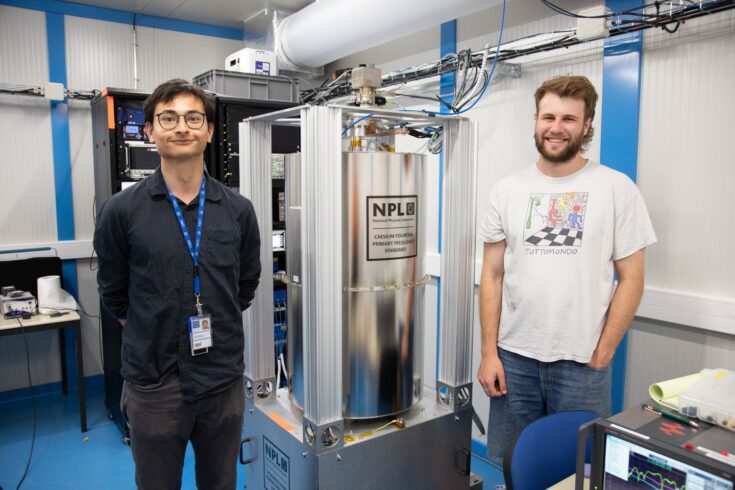Built in the UK with support from the Engineering and Physical Sciences Research Council (EPSRC), it has now been installed at the iconic CERN facility to support the pioneering Antihydrogen Laser Physics Apparatus (ALPHA) antimatter experiment.
The caesium fountain will help ALPHA determine the frequency of light absorbed by antihydrogen (hydrogen’s antimatter counterpart) with the same accuracy as has already been achieved for hydrogen. This is vital to understanding the extent of the symmetry between matter and antimatter, a big question at the heart of how the Universe works.
The caesium fountain was designed and built at the National Physical Laboratory (NPL), the UK’s national metrology institute in Teddington, Middlesex.
Swansea University has led UK involvement in ALPHA, funded by EPSRC. Denmark’s Aarhus University has provided additional support, with funding from the Carlsberg Foundation.
Finding the frequency
The caesium fountain is enclosed in a case around two metres tall. Laser-cooled caesium atoms held in a vacuum chamber are launched up into a magnetically controlled tube before falling back down again.
Microwave radiation measures the frequency with which these atoms oscillate, to the fifteenth decimal place.
This will provide an ultra-accurate reference against which ALPHA can measure antihydrogen atoms’ interaction with laser light, enabling the frequency of light that antihydrogen absorbs to be determined.
The goal is to achieve a level of precision that represents a thousand-times increase compared with current knowledge. It is anticipated that this will be achieved within the next few years.
Solving the antimatter conundrum
One of just a few of its kind in the world, this caesium fountain is unique in its reliability and robustness, crucial to withstanding the demands ALPHA will place on it.
Integrating the instrument with the experiment onsite avoids ALPHA having to access this kind of capability via satellite link, minimising inaccuracies in measurements taken.
The results will show whether, in-line with conventional theory, hydrogen and antihydrogen have exactly the same (though mirror-image) properties.
This could shed light on why there seems to be very little antimatter in the Universe today, even though it is generally held that equal amounts of matter and antimatter were created in the Big Bang 13.8 billion years ago.
The UK is a key partner in ALPHA and the capability provided by the caesium fountain reinforces the UK’s status as a global leader in the field of low-energy antimatter research.
Underpinning breakthrough discoveries
Jane Nicholson, Executive Director for Research Base at EPSRC said:
This exciting device will further cement the UK’s role as a leading nation in the community of researchers studying the properties of antimatter.
Providing superior accuracy to measure the frequency of light absorbed by antimatter, the atomic fountain clock demonstrates the importance of investment in world class facilities and the role they play in underpinning breakthrough discoveries and is an excellent example of academic and public sector research establishment collaboration.
Benefitting the UK
Professor Stefan Eriksson of Swansea University, who is leading ALPHA’s caesium fountain project, says:
The new caesium fountain is essential to our continuing effort to determine if hydrogen and antihydrogen behave in the same way.
Hopefully what we discover will enhance understanding of the basic building blocks of our Universe. The fountain will also help ALPHA benefit the UK by training researchers who can apply their skills – in instrumentation, for instance – to nationally important fields such as quantum technologies, which are anticipated to have a big impact on society.
Further information
The UK’s contribution to the development of the caesium fountain has been carried out through the five-year project ‘Frequency Metrology for Precision Measurements on Matter-Antimatter Symmetry’.
Led by Swansea University, this is due to run until February 2025 and is receiving a total of nearly £1.5 million in EPSRC support.
Following its construction and testing at NPL’s Teddington headquarters, the device was dismantled and then reassembled at CERN in 2022.
Currently in the process of recommissioning, it is already in use and helping to generate important data.
CERN is the European Organization for Nuclear Research, located on the French-Swiss border and home to the Large Hadron Collider. ALPHA’s work takes place at the Antiproton Decelerator/ELENA complex, often referred to as ‘The Antimatter Factory’.
ALPHA is short for Antihydrogen Laser Physics Apparatus. Swansea University and The University of Manchester are leading the UK contribution to this international initiative.
Quantum technologies harness the physics of quantum mechanics. Potential applications include computing, medical imaging, communications and navigation.

